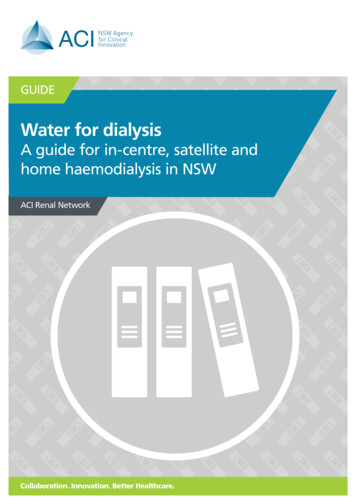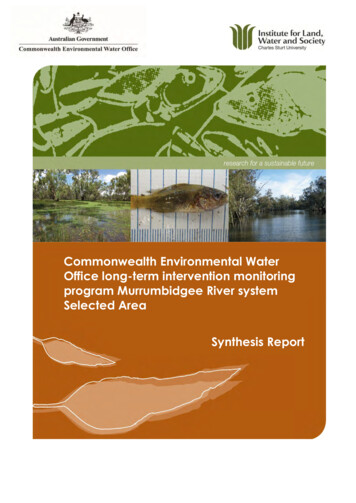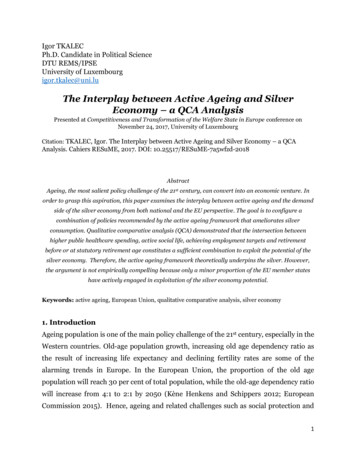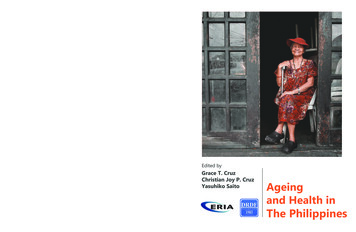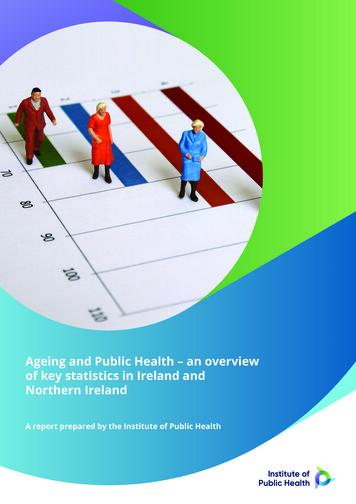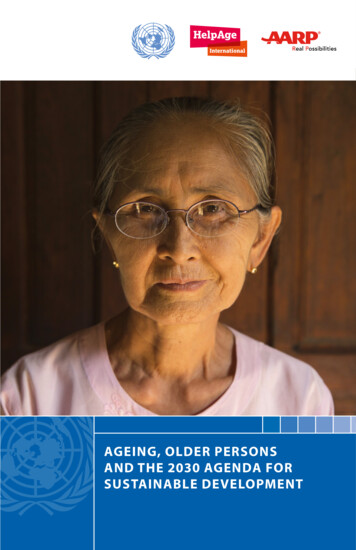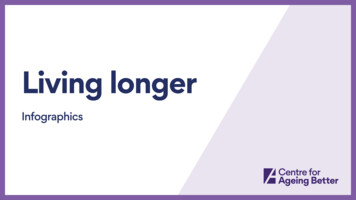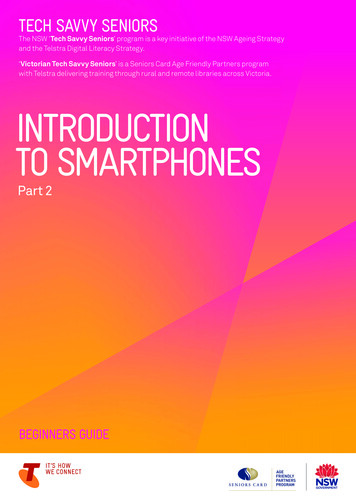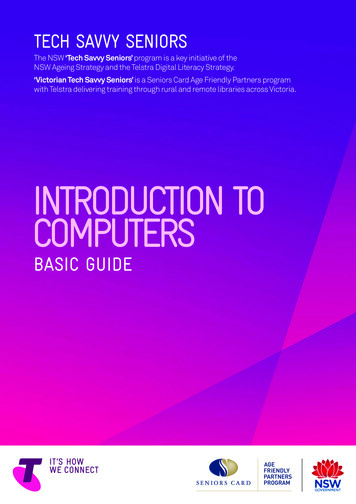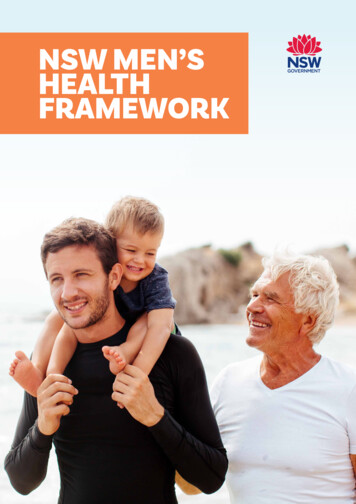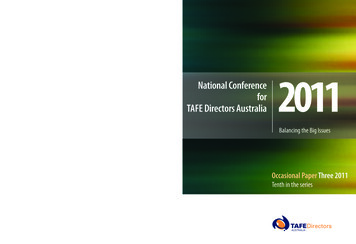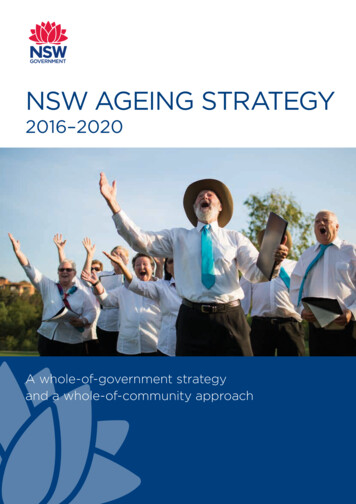
Transcription
NSW AGEING STRATEGY2016–2020A whole-of-government strategyand a whole-of-community approach
NSW Ageing Strategy 2016–2020 3ContentsMinister’s foreword4NSW and Australian policy context6Current initiatives8Our vision9Our strategic approach10Setting the scene12Our priorities for an ageing community18Priority 1: Health and wellbeing20Priority 2: Working and retiring23Priority 3: Housing choices26Priority 4: Getting around29Priority 5: Inclusive communities32Implementation and ongoing conversation36Endnotes39
NSW Ageing Strategy 2016–2020 4Minister’s forewordWho we are as a people, as a community and as a state ischanging. We are getting older. We are living longer thanever before. By 2031, one in three people in NSW will beaged 50 years or older.The ageing population brings with it both challenges andopportunities. The task for all of us – government,academia, business and the community – is how to best manage the challengesand seize the opportunities.The NSW Government is determined to ensure that people not only live longerthan ever before; but live better than ever before. We want older people to livehealthy, active and happy lives as they age.To support this vision, the NSW Government developed the first NSW AgeingStrategy. Released in 2012, the whole-of-community, whole-of-governmentStrategy was designed as a ‘living’ document, which can be renewed over time.The NSW Government has made strong progress in delivering the commitmentsmade under the first Strategy, including the highly-successful Tech Savvy Seniorsprogram, the Elder Abuse Helpline and Resource Unit and the LiveableCommunities Grants program.The renewed Strategy was informed by extensive consultations and dialogue withthe community, experts and stakeholders. As part of this in-depth consultation, asMinister for Ageing I travelled to communities right across NSW to speak directlywith older people about their experiences.The renewed Strategy aims to build on the significant success of the first Strategy.The priority areas are health and wellbeing, working and retiring, housing choices,getting around and inclusive communities.Importantly, responding to the ageing population and delivering meaningful changefor older people requires partnership. Government cannot do it alone. That is whythe NSW Government, through the renewed Strategy, will continue to work closelywith the government and non-government sectors.Thank you to everyone who has contributed to the renewal of the Strategy, and tothose who will work with the NSW Government to make it a reality.The Hon John Ajaka MLCMinister for Ageing
NSW Ageing Strategy 2016–2020 5
NSW Ageing Strategy 2016–2020 6NSW and Australian policy contextResponses to the ageing population differ at local, state and national levels.Nationally, the Australian Government controls some important areas that affectageing policy. This includes income support, taxation and superannuation,workplace relations, higher education and aged care. From 1 July 2012, theAustralian Government assumed primary responsibility for aged care services,including community-based services for people aged 65 and over.Locally, councils and community organisations are well placed to develop andimplement initiatives in local communities.At the state level, the NSW Government is responsible for enhancing opportunitiesfor older people across the state. This includes providing access to mainstreamgovernment services and facilities, like public spaces, transport, health care, socialhousing and justice.We are also responsible for regularly reporting on the state’s long-term fiscalsustainability. The NSW Intergenerational Report 2016, the third in a series ofreports produced by the NSW Treasury, examines trends in population, workforceparticipation, living arrangements and productivity. Projections in the report willinform NSW Government agencies’ planning and actions in response to the statewide shifts brought about by an ageing population.We also need to respond effectively to the changes in demand for governmentservices that will occur over time as our state’s population ages. Agencies acrossthe NSW Government, such as NSW Health and Transport for NSW, are preparingby using existing planning processes to adapt services and infrastructure. Others,like the Department of Family and Community Services, NSW Fair Trading andService NSW, are considering population ageing and the needs and benefits ofolder people in their planning, programs and service delivery. Agencies such asNSW Department of Industry are working with the private sector to helpbusinesses respond to the growing demand for services catering to older people.The NSW Ministerial Advisory Committee on Ageing continues to provide advice tothe government on ageing policy and issues affecting older people in NSW.
NSW Ageing Strategy 2016–2020 7In this context, it is essential that the NSW Government continues to activelyengage with other levels of government to ensure we reflect the interests of olderpeople in NSW and work together on reforms that achieve better outcomes for ourageing population. We are committed to working with the Australian Governmentto maintain a positive and coordinated approach to ageing policy. We will alsopartner with local councils, through the Ageing Strategy, to plan ahead and workstrategically for the benefit of our ageing population.The Ageing Strategy is our commitment to respond to the opportunities andchallenges of our older population. It complements other efforts in NSW to addressageing issues – whether through the 2015 Premier’s and State Priorities, or throughmajor government reforms in areas such as planning, transport, communityparticipation and health, disability and community services, carers and volunteering.
NSW Ageing Strategy 2016–2020 8Current initiativesSince the launch of the Ageing Strategy in 2012, we have delivered on ourcommitment to support older people through initiatives such as the highly successfulTech Savvy Seniors program, establishing the state-wide Elder Abuse Helpline andResource Unit, the growing Liveable Communities Grants program and theexpansion of the NSW Seniors Card to include more deals for older people.This Strategy seeks to build on these achievements, as well as introduce otherinitiatives that reflect the feedback received from older people across NSW.Highlights More than 30,000 training places taken up since the launch of Tech SavvySeniors, with the courses offered in eight languages other than English The first Tech Savvy Seniors Road Show kicked-off on 31 March 2016 andtoured nine regional communities to educate Aboriginal Elders in the useof technology Twenty-four projects have been funded through the Liveable CommunitiesGrants program in 2015–16 There are now more than 1.45 million Seniors Card holders in NSW Seniors Card members can access more than 4,500 participating businessoffers across 2,300 unique businesses Transport concessions for eligible older people have been maintained More than 1 million Gold Opal Cards have been issued to Seniors Card holdersand pensioners Continued support for Grandparents Day, which is now an established event Introduced the Real Men Move initiative, encouraging older men to liveactive lifestyles Over 4,500 calls were made to the Elder Abuse Helpline and Resource Unit Over 30,000 people are now more aware of the importance of preparing a will,making a Power of Attorney, appointing an Enduring Guardian and discussingadvance care planning through the Getting it in Black and White Campaign.
NSW Ageing Strategy 2016–2020 9Our visionPeople in NSW experience the benefits of livinglonger and enjoy opportunities to participate in,contribute to and be included in their communitiesGetting older is a normal and natural phase of life and is something to be valued.People living longer is positive for individuals, and also presents social andeconomic benefits to the wider community of NSW. But to fully experience thebenefits of living longer, NSW needs to better plan for ageing. This must happen atthe individual and community levels, because we know that ageing affects everyone.Responding to the opportunities and challenges of an ageing population meansthat government, the private sector and the wider community must work together.We recognise that the experience of ageing is different for everyone and happensat different times. For the NSW Ageing Strategy to be most effective, we arefocused on people in NSW who are aged 50 years and over.1
NSW Ageing Strategy 2016–2020 10Our strategic approachLife stagesThere is no specific age at which a person becomes ‘old’, and age categories do notdefine a person’s lifestyle, aspirations or needs. A life stage approach recognises thatpeople experience the ageing process in different ways and at different times.Recognising diversityOlder people are as diverse as the rest of the community and will have differentexperiences of, and views on, ageing. We will consider the needs of older peoplewho are: Aboriginal Culturally and Linguistically Diverse (CALD) Lesbian, Gay, Bisexual, Transgender or Intersex (LGBTI) have caring responsibilities have a disability, dementia or chronic disease live in rural or remote areas.We will also focus our efforts on disadvantaged and vulnerable communities.
NSW Ageing Strategy 2016–2020 11Person-centredOlder people should be supported to make their own decisions. By adopting aperson-centred approach, we can support people’s individual choices, and helpthem to take responsibility for their futures by empowering them to plan ahead forthe lives they want to lead as they grow older.Whole-of-government and whole-of-communityAgeing impacts all areas of NSW. We will work to build a strong culture of sharedresponsibility across the NSW Government to ensure all agencies are committedto collaborating and planning ahead for the future needs of our ageing population.We will engage with the private sector (for-profit and not-for-profit), other levels ofgovernment, and the wider community to raise awareness of the benefits andneeds of our ageing population.State-wide change and locally-driven responsesSome opportunities and challenges of an ageing population need consistent statewide responses, while local decision-making can generate the best responses tolocal experiences. All NSW Government agencies need to plan for state-wide shiftsin service demand to meet changing demographics, and engage with communitiesto identify opportunities and solutions that work for their local community.
NSW Ageing Strategy 2016–2020 12Setting the sceneAgeing in NSWThe ageing population has changed life in NSW, as it has around Australia, and willcontinue to transform what NSW looks like in the future.The number of older people in NSW is increasing and the proportion of olderpeople within the total population is also growing.In 1991, there were almost 700,000 people aged 65 and over in NSW, and morethan 800,000 aged 50 to 64.2 In 2011, more than one million people in NSW wereaged 65 and over, and more than 1.3 million were aged between 50 to 64.3 By2031, around 20 per cent of NSW, or 1.8 million people, will be aged 65 and over,and more than 1.5 million will be aged 50 to 64.4 Together, more than one in threeNSW residents will be aged 50 or above by 2031.At the same time, our life expectancy is improving. In 1972, the average lifeexpectancy for the total NSW population at birth was 68 years for males and 74.8years for females.5 Life expectancy for male babies born in 2015 is 80.8 years, and85 years for female babies.6 Men and women born in 2056 are expected to live for88.6 years and 91.4 years respectively.7While our general life expectancy continues to climb, there is more work to do toclose the gap between Aboriginal people and the rest of NSW, with life expectancyfor Indigenous people in NSW at 70.5 years for men and 74.6 years for women.8There are also changes to ‘healthy-life expectancy’ – that is, the number of yearspeople live without a severe or profound core disability. For those born in 2012,males can expect an estimated 74.2 years of life without a severe or profound corelimitation, while females can expect 76.5 years. This is an increase of around 3.5years for males and 2.6 years for females since 1998. But while healthy-lifeexpectancy has increased, there has also been a proportionate increase in thenumber of years spent with a core disability.9As the population ages, the number of people with a severe or profound core disability,and the average time for which they will have that disability, is likely to increase.10In the future, where older people choose to live in NSW will also change. About 67per cent of people aged 60 and over now live in a city or metropolitan area of NSW,with around a quarter living in a regional city, and less than one in 10 living in a ruraltown or remote area.11However, the proportion of older people who live in regional and rural areas ofNSW will grow faster than in metropolitan Sydney,12 though there will be majorvariations across regional NSW.13
NSW Ageing Strategy 2016–2020 13And the characteristics of older people in the future will change as differenteconomic, social and cultural environments influence people’s attitudes andlifestyle choices.Many Aboriginal communities in NSW continue to experience higher levels ofsocioeconomic disadvantage than the broader population, as well as limitedaccess to services, especially in rural and remote areas. They may also facegreater pressures from family, caring and community responsibilities.Some CALD communities are ageing at a faster rate than non-CALD communities,particularly as a result of past migration patterns.
NSW Ageing Strategy 2016–2020 14What does this mean for NSW?An ageing population underscores the health, social and economic progressacross the state. However, the growing number of older people in NSW alsochanges our communities in new ways. Every community in NSW will evolve asthe ageing population impacts our economy, labour market, healthcare and otheressential services, as well as the fabric of our communities.Responding to these changes is everyone’s business – government, the privatesector and not-for-profit organisations, communities and individuals. Together, weneed to respond to and prepare for a wider range of life experiences as peoplegrow older. We must also encourage people to plan for their own futures, as theymay face many more years of later life than previous generations, including afterretiring from the workforce.The growing number of older people in NSW offers many benefits. Older peoplecontribute to the economy and society as volunteers, as paid full- or part-timeworkers, and as students in further education. They also contribute through thesupport they provide to family members and others, including as carers. Theyinfluence the economy as consumers, as their demand for services creates newmarkets and expands existing ones. Older people contribute to a more inclusive,broader community.
NSW Ageing Strategy 2016–2020 15But the needs of an ageing population also create a range of challenges forgovernment, the private sector and not-for-profit organisations, communities andindividuals. Older people need and want support and services that help maintain orimprove their health, wellbeing and quality of life. People ageing today needemployment opportunities that support their financial independence during later life,particularly in light of the decreasing rates of housing affordability and homeownership. As people age, changes in mobility and the availability of suitable transportoptions affect how they access recreation, shopping, medical care, social servicesand other social activities. Now and in the future more people in our communities willbe older, and may face isolation, loneliness, a lack of respect and even abuse.Renewing the NSW Ageing StrategyThe NSW Ageing Strategy was first released in July 2012. Designed as a ‘living’document, it underpins all NSW policy, projects and supports related to ageing.The Strategy continues to be refined based on the themes and ideas brought forwardby older people, the Ministerial Advisory Committee on Ageing, led by Kathryn GreinerAO, and experiences from the first Strategy.In 2016, after an independent evaluation found the majority of initiatives had beencompleted or were substantially underway, the NSW Government embarked on arenewal of the Strategy.To ensure the renewed Strategy is evidence-based and informed by older people andkey partners, the Minister for Ageing, the Hon. John Ajaka MLC, undertook a statewide ‘Listening Tour’. Over 160 people participated in consultations acrossmetropolitan, rural and regional locations, including Port Macquarie, Griffith, Bathurst,Goulburn, Nowra, Parramatta, Dubbo, Hawkesbury, Broken Hill and Tamworth.Community members, older people and interested stakeholders were also invited tohave their say via an online survey, which attracted over 700 responses.The Minister for Ageing also hosted a roundtable with private sector representatives.The roundtable focused on how government can better work with the private sector,including harnessing their ideas and innovation to deliver the best outcomes for olderpeople in NSW.Advice was also sought from Multicultural NSW on the impacts of ageing on culturallyand linguistically diverse communities.Building on the ongoing dialogue with older people and partners in government, thecommunity and the private sector, further targeted consultations were undertaken togain perspectives from the broadest range of people possible. Overall, the governmenthas heard from more than 4,300 older people of varying ages, cultural backgrounds andlocations in NSW, through local meetings, focus groups and online surveys.The results of these consultations are reflected throughout the Strategy.
NSW Ageing Strategy 2016–2020 16Key findings from the consultation include:Older people in NSW are generally optimistic, though realistic, about growing older.Being healthy and living longer is seen as a blessing, although it also causes someworry around planning for getting older.Older people strongly believe: everyone can learn a lot from older people getting older is a great opportunity to pursue new interests and enjoy life growing older does not bother them.Further, the older people we consulted with do not think of themselves as old.They also recognise that, as people get older, they are likely to face issues aroundloneliness, poorer health and changes to their lifestyles, and often do not getrespect in society.Some of the most important things for people in NSW as they get older are: staying independent and physically and mentally healthy for as long as possible being able to get around on a daily basis for as long as possible.This is followed by: staying financially independent for as long as possible having easy access to a range of transport options maintaining solid social ties and staying in close contact with family, friends andthe community remaining in their current home for as long as possible.
NSW Ageing Strategy 2016–2020 17People aged 50 to 60 years have told us they are most looking forward to travelling,spending more time with family and friends, and relaxing in the next 10 to 20 yearsof their lives.However, they also have some concerns about the future, as they begin to feel theeffects of ageing. Declining health or illness is the most concerning aspect of laterlife, followed by concerns about future financial security.While almost a quarter of people aged 50 to 60 years say they have consideredtheir life as they get older to a ‘great extent’, and a further three in five have put someconsideration into future planning, almost one in five have done little or nofuture planning.‘Ageing’ starts earlier in Aboriginal communities, with many Aboriginal peopleexperiencing age-related issues like chronic disease, financial hardship and forcedretirement at 50 years or earlier. Some Aboriginal people are getting older at thebusiest time of their lives, due to family and community responsibilities.Older people from CALD backgrounds who migrated to Australia at later agesoften face cultural or language barriers as they look for work or to participate in thewider community.Altogether, this consultation has helped us to understand the needs of olderpeople, and to adapt our Strategy and responses to new or emerging priorities.We remain committed to speaking with and hearing from older people and otherpartners in government, the community and the private sector across NSW overthe life of the Strategy.
NSW Ageing Strategy 2016–2020 18Our priorities for an ageingcommunityOne of the priorities of the NSW Government is to promote opportunities for olderpeople to lead active and rewarding lives and ensure NSW responds effectively tothe challenges and opportunities of an ageing population.Through this Strategy, we will focus on five priorities that older people across NSWhave said are important to them:1. Health and wellbeing2. Working and retiring3. Housing choices4. Getting around5. Inclusive communities.These priorities strongly align with the World Health Organisation’srecommendations for ageing well and creating an age-friendly world.14These priority areas are interconnected, and we recognise that making changesin one area can improve experiences for older people in another. For instance,improvements in planning ahead and financial security may also enhance an olderperson’s health and wellbeing, while improvements to transport options mayimprove an older person’s ability to maintain connections with their community.Projects and initiatives under each priority area will be outlined in the Strategy’simplementation plans.
NSW Ageing Strategy 2016–2020 19
NSW Ageing Strategy 2016–2020 20Priority 1: Health and wellbeingObjectiveOlder people in NSW are encouraged to liveactive and healthy lives with improved physicaland mental wellbeing.I’m very proud of my fitness, and I love to show people my muscles. It’s good to getup, get dressed, get out, and have a destination. Margaret, 89Older people in NSW want to live healthy and independent lives for as long aspossible. Although ideas of what good health and wellbeing looks like can varyacross NSW, older people generally see this as one of the most important parts ofretaining a good quality of life. They also know that this includes mental andemotional wellbeing.A person’s experience of wellbeing depends on factors like physical and mentalhealth, disability, cultural background, feelings of loneliness and social isolation,socioeconomic status, living arrangements and location.
NSW Ageing Strategy 2016–2020 21What are older people telling us?All people can struggle to maintain good health. People in NSW approaching laterlife say that some of their key concerns centre on their health and wellbeing.Greater reliance on medication, hospital waiting lists and access to health services,fear of dementia, and how to balance regular activity with increasing aches andpains are common challenges.15In light of this, making sure that older people prepare for their future health andcare needs is essential. But while some people are thinking about how they mightmanage their health as they age and are taking action to improve and maintaintheir health, others are more motivated at crisis points. Regardless of culturalbackground or location, less than two thirds of those we spoke with across NSWhave actually prepared for their own or their partner or spouse’s future health andcare needs – such as planning where and how to live, thinking about who canprovide support, having conversations with family members, or seeking advicefrom health or legal professionals.Carers play a key role in supporting their families and friends as they age. Theyinclude both carers who are ageing and those who care for older people. Caringroles can require a lot of time and energy and are associated with poor physicaland mental health. Many more informal carers will be needed in the future as ourpopulation ages, but only 35 carers are expected to be available for every 100people needing informal care by 2031.16Across NSW, we have heard how important it is to encourage older people to havefit and healthy lifestyles through activity and diet. Older people say that maintaininghealth can support independence and community engagement. They have told usthat health services need to be more affordable and accessible for older people.These supports also need to be appropriate and inclusive for older people who areAboriginal or from CALD backgrounds, for the ageing LGBTI community and HIVpositive older people.
NSW Ageing Strategy 2016–2020 22We have also heard that older people have divergent views on how they want tolive at the end of their lives, including the role of palliative care. Older people withchronic disease or other complex health conditions often require assistance tocoordinate their care so that they can navigate the primary, hospital andcommunity care sectors. We also know that it is important to address olderpeople’s mental health needs and promote social inclusion.How will the NSW Ageing Strategy respond?The NSW Government is already supporting the health and wellbeing of olderpeople through initiatives like Make Healthy Normal, the Get Healthy Information andCoaching Service, the Get Healthy at Work program, and the Stepping On program.Over the next four years, we will focus our efforts on working with partners across theNSW Government and in the community to increase the proportion of older people inNSW who live active and healthy lives with improved physical and mental wellbeing.Under this Strategy, we will: plan our health services and infrastructure in light of our ageing population continue to explore greater integration across the health and communitysectors, and support a partnership approach with primary care and otherstakeholders to prevent and manage chronic disease investigate new approaches and technologies to reach older people andsupport their health and wellbeing continue to establish education and prevention strategies to minimisebehaviours that risk health and wellbeing, to promote healthy living and ahealthier ageing population over time encourage our partners in the private sector and community to provide servicesfor older people focus our own efforts on people who are ageing in NSW who may need furtheror more targeted support – such as those on low incomes, carers, Aboriginalpeople, and people with mental health issues or dementia.
NSW Ageing Strategy 2016–2020 23Priority 2: Working and retiringObjectiveOlder people in NSW have opportunities toremain in the workforce, are financially secureand independent in retirement, and plan theirfinances based on their circumstances and needs.Our mature aged workers inspire our customers with their experience and ideas,and play an important role as mentors for their younger colleagues. BunningsAs many people in NSW face longer lives than in the past, the importance ofmaintaining paid work for longer increases. Older people in NSW know that beingable to remain in or return to the workforce can improve their wellbeing, as well astheir financial security and independence. Older people in the workforce alsoenhance our national and state economies. Equally, when older people are notable to access paid work, there is a financial cost to employers, government andthe individuals themselves. However, barriers to paid work are significant and someolder people are particularly vulnerable. Planning ahead to help people extend theirworking lives, if that is what they want, enjoy a high quality of life after retirement,and manage finances are very important.
NSW Ageing Strategy 2016–2020 24What are older people telling us?Older people in NSW have said they face many challenges in finding andmaintaining employment.Declining physical health is a common issue that prevents people from working,particularly older men, people with lower education levels and incomes, or those inmanual occupations. Caring responsibilities also mean that some older peoplehave moved in and out of employment over their working lives.17 Many workplacestructures, including physical work environments, are not flexible and do notprovide enough opportunities for older people. A lack of work-related insurancecoverage after reaching pension age makes it hard to stay in work. Some olderpeople from CALD communities say they find it harder to continue or return toemployment if they moved to Australia at later ages due to language barriers.Ageist attitudes among some employers can lead to discrimination. Ageist beliefscan include thinking that older workers have out-dated skills, are less committedand flexible, or are too slow to learn new things. Age discrimination is a commonconcern, and can discourage and prevent older people from staying in orre-entering the workforce.A large proportion of older people are not re-thinking their careers and workopportunities as they age. They often do not have a clear idea of when and howthey will retire. They also feel less confident than younger people that they can findanother job if their employment situation changes. The shifting nature of industriesand employment can mean that training is important for older people to gain ormaintain work. Many workers aged 50 years and over believe training would helptheir employability, but this belief declines with age.Older people say that they are concerned about their income and financial securityleading up to and during retirement. Without this security, older people are morevulnerable to social isolation and declining independence. On average, people whoare employed have realistic views about how long they n
At the same time, our life expectancy is improving. In 1972, the average life expectancy for the total NSW population at birth was 68 years for males and 74.8 years for females.5 Life expectancy for male babies born in 2015 is 80.8 years, and 85 years for female babies.6 Men and women born in 2056 are expected to live for
